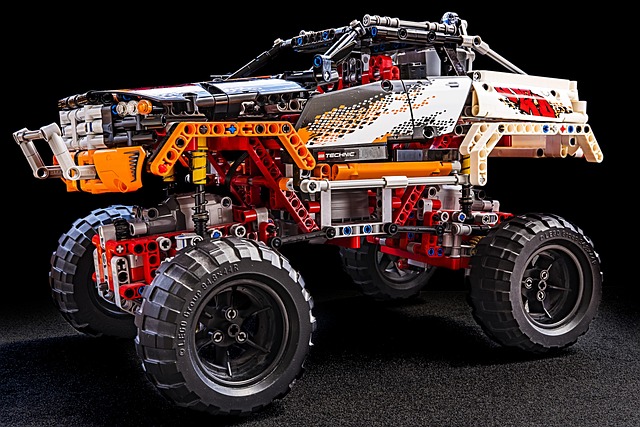TL;DR:
Tips From Brownsville's 4×4 Suspension Specialists emphasize the importance of regular brake pad inspections and upgrades for optimal vehicle performance and safety. Organic and metallic pads offer differing stopping capabilities, with organic pads providing smoother stops and metallic pads offering aggressive braking. Wear patterns vary based on driving style and conditions. Upgrading to high-performance brake pads enhances braking power, quickness, control, and durability, reducing maintenance needs and increasing safety for both off-road enthusiasts and everyday drivers. Replacing brake pads involves parking on a level surface, jacking up the vehicle, removing wheels and calipers, inspecting/replacing pads, reinstalling wheels, and lowering the vehicle safely – professional help is recommended for complex models.
“Keep your vehicle’s stopping power optimal with expert insights from Brownsville’s leading 4×4 suspension specialists. This comprehensive guide dives into the world of brake pad replacement and upgrades, equipping you with essential knowledge for safer driving. Discover different types of pads and their wear patterns to make informed choices. Learn the advantages of high-performance brakes and master a step-by-step process for DIY replacements or understanding when professional assistance is key. Optimize your vehicle’s stopping capabilities with these expert tips.”
- Understanding Brake Pads: Types and Wear Patterns
- The Benefits of Upgrading to High-Performance Brake Pads
- Step-by-Step Guide: How to Replace Brake Pads Yourself (or When to Seek Professional Help)
Understanding Brake Pads: Types and Wear Patterns
Brake pads are a vital component of your vehicle’s braking system, and understanding their types and wear patterns is essential for maintaining optimal safety on the road. Tips from Brownsville’s 4×4 Suspension Specialists suggest that there are primarily two types of brake pads: organic and metallic. Organic pads, often found in lighter vehicles, offer smooth stopping power but may leave subtle dusting due to their composition. Metallic pads, more common in performance or heavy-duty trucks, deliver aggressive braking with less fade but can produce higher levels of noise and dust during use.
Wear patterns also vary; some pads show uniform wear, while others exhibit uneven degradation. This is influenced by factors like driving style, road conditions, and vehicle weight. Regular inspection can help identify when brake pads need replacement. By keeping an eye on these aspects, Brownsville’s 4×4 Suspension Specialists recommend, you ensure your brakes function at their best, enhancing control and safety during every drive.
The Benefits of Upgrading to High-Performance Brake Pads
Upgrading to high-performance brake pads can significantly enhance your driving experience, especially if you’re an off-road enthusiast or just looking for better control on the road. Tips from Brownsville’s 4×4 Suspension Specialists highlight several key benefits of making this upgrade. First and foremost, these advanced pads offer improved braking power and response time, allowing for quicker stops and better control during high-speed maneuvers or unexpected situations. This enhanced performance not only increases safety but also adds a new level of confidence to your drives.
Additionally, high-performance brake pads are designed to withstand extreme temperatures and provide consistent friction, reducing the risk of sudden braking failures. They often feature advanced materials that offer better heat dissipation, which is crucial in preventing overheating and prolonging the lifespan of your brake system. By choosing these upgraded pads, you’re investing in improved durability, reduced maintenance needs, and peace of mind, ensuring your vehicle’s brakes are up to the task, whether tackling rugged terrain or navigating dense city traffic.
Step-by-Step Guide: How to Replace Brake Pads Yourself (or When to Seek Professional Help)
Replacing brake pads is a crucial task for maintaining your vehicle’s safety and performance, especially if you’re an avid off-roader or 4×4 enthusiast. At Brownsville’s 4×4 Suspension Specialists, we’ve put together this step-by-step guide to help you understand the process. However, keep in mind that for those new to car maintenance or with complex vehicle models, seeking professional help might be the safest bet.
Here’s what you need to do:
1. Safety First: Park your vehicle on a level surface and engage the parking brake. Ensure the engine is off and let it cool down before beginning. Remove any loose items from under the car for clear access.
2. Jack Up & Support: Use a jack to lift the vehicle until the wheel you’ll be working on is about 6 inches above the ground, then place sturdy jack stands in proper positions to secure the vehicle.
3. Remove Wheel & Caliper: Unscrew and remove the lug nuts using a torque wrench, then carefully pull off the wheel. Next, locate the caliper bolts and, with the help of pliers or a socket, detach them, being careful not to damage the brake pads.
4. Inspect Pads & Hardware: Remove the old brake pads and inspect both them and the caliper for wear, corrosion, or damage. Replace any worn-out hardware.
5. Install New Pads: Position new pads in place within the caliper, ensuring they’re properly seated. Reattach and tighten the caliper bolts securely.
6. Reinstall Wheel & Lower Vehicle: Put back on the wheel, retighten the lug nuts by hand, then lower the vehicle with the jack stands before tightening them fully with a torque wrench.
When considering brake pad replacement and upgrades, arming yourself with knowledge is key. By understanding different types and wear patterns, you can make informed decisions about your vehicle’s safety and performance. Following our step-by-step guide or seeking expert assistance when needed, you’ll be well on your way to enhancing your 4×4’s braking capabilities. Tips from Brownsville’s 4×4 Suspension Specialists highlight the benefits of high-performance pads, ensuring a smoother, more controlled driving experience. Embrace these upgrades for peace of mind and improved vehicle control on every journey.
